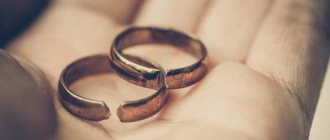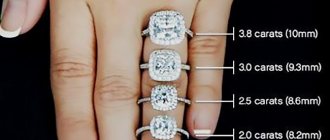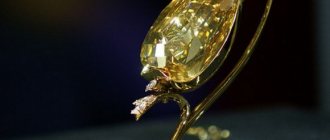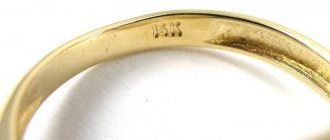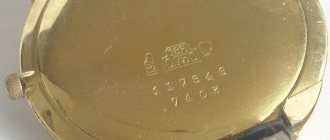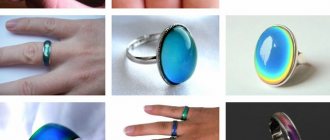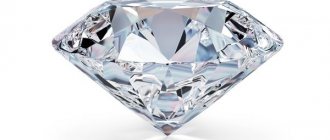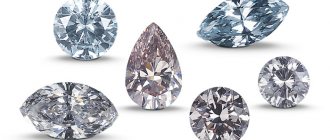Photo of a 1 carat diamond ring on a hand
Some sources suggest a less likely version of the origin of the word "carat" from the word kuara, the local name for the coral tree Erythrina corallodendron, the average weight of a seed of which is approximately equal to the average weight of an acacia seed.
It is interesting to note that among the Greeks, the seed of the acacia Ceratonia, as well as among the Romans, its equivalent - the siliqua seed, served as a weight, and in the time of Emperor Constantine, a solidus gold coin was issued weighing 24 such seeds. It is likely that this served as the source of another, modern meaning of the word “karat” as a measure of the purity (fineness) of a gold alloy. For example, 18 karat gold (18k gold) contains 18 parts gold and 6 parts other metals.
Ring No. 12 with diamonds 0.39 carats, 0.52 carats, 0.96 carats.
If diamond size is critical when you're on a budget, we recommend choosing a diamond from a nearby weight group. For example, a diamond weighing 0.96 carats mounted in a frame looks like a 1 carat diamond, having a significantly lower cost.
How big is a one-carat diamond?
A carat is a measure of weight, and one carat is equal to 200 milligrams or 0.2 grams.
How big a one-carat diamond looks depends on its size. These dimensions, in turn, depend on the cut of the stone.
Let's look at the approximate measurements of a one-carat stone depending on its cut:
- Round cut: approximately 6.5mm in diameter
- Square cut, princess and asscher: approximately 5.5mm long
- (Rectangular) Emerald Cut : Approximately 6.5mm long x 5mm wide (these sides may vary)
- Radiant and cushion cut: approximately 6.0-6.5 by 5.0-5.5 mm
- Oval and Pear Cut: Approximately 8.0-8.5mm long and 5.0-5.5mm wide
- Marquise cut: approximately 10mm long x 5mm wide
Please keep in mind that all of these numbers are approximate and the actual size may vary depending on the proportions of the particular stone.
Romance with the stone
Sales of gemstones around the world are increasing even during the pandemic.
Just since the beginning of this year, the demand for diamond jewelry in the salons of MIUZ Diamonds (the new name of the Moscow Jewelry Factory after a large-scale rebranding) has increased by no less than 50%. What is the reason for this trend? In fact, everything is simple: amid the lockdown, the demand for entertainment, travel and clothing has decreased, but for expensive gifts has remained the same - wealthy people were not ready to give up the joys of acquiring jewelry. Moreover, the problem of closed borders for diamonds does not exist, and domestic stones have an excellent reputation. Photo MIUZ
How to make a diamond in a ring appear larger?
There are several factors that affect how large a diamond appears when set in a ring: the type of setting, the cut of the stone, and its shape.
How does the ring setting affect the size of the diamond?
Some settings leave more of the diamond surface visible than others.
For example, prongs do not cover the same amount of the stone's surface as rim or channel settings.
A setting that holds the diamond with four or six prongs can be a good choice if you want to show off as much of your stone as possible and make it appear larger.
Diamond shape and its effect on size.
Some diamond shapes tend to look larger than others, even if they have the same carat weight.
If you want to create the illusion of size, look for wide shapes. For example, a square asscher cut diamond will appear larger than a narrow marquise cut diamond.
However, it's not just the shape that matters when it comes to appearance.
Sometimes, the way a diamond is cut can make it look smaller even though its shape is wide and square. This is why you should also consider the importance of cut.
Cut as a factor in diamond size.
The way a diamond is cut can greatly affect how it looks. Deeper cuts appear smaller than shallower ones, as long as the stones being compared are of the same carat weight.
For example, the princess cut has more depth compared to the emerald cut.
In general, if you want a diamond whose surface appears larger when set in a ring, look for shallow cut stones.
Don't forget, however, that each cut has certain ideal proportions, and if the depth of the diamond you buy deviates significantly from the standard for a particular cut, its brilliance may be reduced.
This is especially true for brilliant cuts such as round.
Diamond size and finger size.
Finally, be sure to consider the wearer's hand when choosing the size of the diamond in the ring.
Wide fingers can make a diamond appear smaller than it appears when placed on a hand with thinner fingers.
Also, consider the fact that elongated diamond shapes make the fingers appear longer, while wider shapes emphasize the width of the hand.
Does a larger diamond always look better on your finger?
Ladies say that the larger the diamond, the better. Well, I disagree because I don't think everyone would look good with a diamond that's too big on their hand.
Conversely, a small diamond would look disproportionate if the recipient had thick fingers. When choosing the right carat size, it will definitely help if you can imagine how the ring will look on the recipient's finger.
Is more (left) always better? Personally, I don't think so due to the excessive size.
Why aren't diamonds sold in standard carat weights?
Did you know that all those 1-carat diamonds may not weigh exactly 1 carat? Stated values are approximate.
Although diamond carat weight is expressed in standard values such as 0.5, 0.75, 1, etc., in reality, it is rare to have a stone that weighs exactly one of these numbers.
A one-carat diamond can actually be 0.95 or 1.05 carats. This is why you shouldn't expect two diamonds with the same carat value to be exactly identical in weight.
In fact, it is completely normal that the diamond weight is not an exact number and it is usually noted that this number is an approximation.
This is normal practice and is usually not hidden; you can always find the exact carat value on the diamond certificate (or grading report).
It is often impossible to cut a diamond so that its carats exactly correspond to the standard size.
A jeweler cutting a diamond crystal will generally try to obtain one or more stones that are of the highest possible quality.
For example, a carat can be deliberately reduced by cutting out segments that contain many natural imperfections, thereby improving the clarity of the diamond.
Or the jeweler may want to get rid of some parts of the crystal to create a more proportional cut, which increases the sparkle of the stone.
However, the carver will also try to use as many raw materials as possible and minimize waste. As a result, the cut stone will have a weight that will be close to one of the standard values, but there will always be some deviations.
What is the normal carat deviation?
Typically, the actual weight of a diamond will vary between 0.06 and 0.08 of its advertised value.
For example, a 0.94 carat diamond would be sold as a one carat stone. Or, a diamond that is stated to be 0.75 carats may actually be closer to the 0.8 number.
You can always ask the salesperson at the jewelry store about the exact weight of the diamond he shows you. You can also check this number on the diamond grading report - it should be mentioned there.
Net Benefits
Another key characteristic of a diamond is its clarity. In order to characterize the clarity of a stone, the appraiser examines it at 10x magnification, armed with an achromatic aplanatic loupe. The highest type of clarity - FL, or Flawless ("perfectly clear") - is assigned to those diamonds that are free of stains, pits, scratches and inclusions. They belong to the most expensive category.
This is followed by IF, or Internally Flawless, if the appraiser does notice small, barely visible stains. If you are considering a diamond as an investment, you will have to decide what type of clarity to choose. Be that as it may, careful storage of diamonds will not affect the depth of brilliance of their facets, no matter how many years pass. More budget-friendly types of clarity with small inclusions and stains (of course, obvious only to an expert) provide nuggets with a lower price, but will still fit perfectly into the design of jewelry.
Photo MIUZ
When it comes to color, colored diamonds have come into fashion over the past few years. The championship is confidently held by yellow (the most common) and pink (the rarest). Stones of unusual shades are steadily growing both in price and in demand: their owners even have their own association, The Fancy Color Research Foundation (FCRF), uniting 24 companies. However, colorless diamonds are still considered the favorite and most expensive diamonds. In the end, the classics have no competitors. The official GIA (Gemological Institute of America) color grading scale assigns a diamond a letter from D to Z, with D meaning “completely colorless” and Z meaning “light yellow or brown.” The MIUZ assortment includes both colorless and colored stones - the final say in the choice, of course, remains with the buyer.
How visible is the difference in carat weight?
Of course, if you compare a 0.75 carat diamond to a one carat diamond, you will notice the difference.
However, when the deviation is between 0.05 and 0.1 carats, it is difficult to detect. If a 0.95 carat diamond is placed next to a 1.02 carat diamond, for example, you will likely have a very hard time telling the difference.
You should expect to pay a little more for a diamond that is slightly above the 1-carat or 0.5-carat mark (or above any standard value).
This works both ways. If the diamond is 0.05 less than 1 carat or some other standard value, then you will pay less.
How important is carat when it comes to price?
Carat weight is one of the most important factors in determining the price of diamonds.
Increasing the carat weight will result in a disproportionate increase in the cost of the stone.
For example, a two-carat stone will not cost twice as much as a one-carat stone; the actual price difference will likely be three or four times that.
The most popular carat values are usually round numbers (1 ct, 2, etc.) and their fractions (0.25, 0.50, 0.75, 1.50, etc.).
Knowing these in-demand quantities is important because it can help you save money on your purchase.
The carat value is clear
However, the average buyer needs a more practical way to determine the size of the stone. To do this, I decided to illustrate the difference in carat weight in one photo using several diamonds provided by King Jewelers. David King, company owner and diamond expert, selected 6 round brilliant cut stones, each with the perfect degree of polish, symmetry and cut.
The photo below shows my hand (I wear size 15.5 on my index and middle fingers) and 6 diamonds, arranged in ascending order:
- 0.50 ct, VS-2 clarity, F color
- 1.00 ct, VS-2 clarity, G color
- 2.01 carats, clarity SI-1, color F
- 3.01 carats, clarity SI-2, color G
- 4.02 carats, clarity SI-2, color G
- 5.59 ct, VS-1 clarity, G color
Use of 9 karat gold
However, 375 sample also has special areas of application. Products made from this material have properties that are not typical for products made from pure noble metals: first of all, they are distinguished by lightness and hardness. In this regard, this material is widely used for inlaying everyday items of constant use, as well as for the manufacture of everything for which mechanical strength is important: watches, cigarette cases, and the like. Also, 375 gold is well suited as a material for wedding rings: they are durable and comfortable (but there is a risk of an allergic reaction).
It should also be noted that jewelry made from an alloy containing only 37.5% pure gold may lose its original luster over time, like jewelry made from silver and copper. The rules for caring for such jewelry are similar to the rules for handling silver jewelry.
Cleaning from copper and silver salts is carried out in an alkaline environment. It is often recommended to use ammonia, soda solution, or a mixture of both.
The soda solution can be heated to a boil, but you should still not boil jewelry in it. But dishwashing detergent, washing powder, toothpaste, glass cleaning liquid or regular soap also help.


